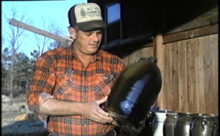The Kiln and Its Firing
Jerry Brown uses a rectangular shaped "tunnel kiln" derived from the earlier "groundhog kiln". Groundhog kilns are uniquely southern kiln types which were used to fire alkaline glazed pottery in the 19th century. The groundhog kiln was semi-subterranean in construction featuring a doorway leading into a long, low passage of brick or rock construction, which terminated in a chimney poking out of the ground, up hill. The ware was loaded in the low passageway or "ware-bed" and the fire was built in the sunken firebox, located just inside the door. The chimney would draw the heat from the fire through the pottery inside. This type of firing or " burning " worked well with large pieces of pottery. Later, when potters made more and more smaller items they found that kilns shorter in length but higher were better for insuring that each small piece was fired and glazed properly (Zug 1986:401). This new type of kiln is built entirely above the ground but features some characteristics of its ancestor, the groundhog kiln. It is still rectangular in both plan and profile. The ware is still loaded in a front door and there is a chimney in the rear. To replace the insulation that building into a hillside once provided, mounds of dirt are built up on both sides of the kiln. There also is a firebox still located just inside the door.
In the film we see Jerry fire his kiln much the same way his ancestors did 150 years ago. After stacking the glazed and dried ware, he built a small fire at the door of the kiln. After a few hours he slowly began moving the fire inside the kiln, into the firebox. This slow, careful procedure allowed for a gradual increase of the air temperature inside the kiln to drive off any vestige of moisture that might still be in the pottery. After eight hours, he allowed the fire to grow more quickly by adding lots of wood and raising the temperature sufficiently to melt the glaze and fire the clay body of each vessel.
Since 1988, Jerry has used natural gas to fire his kiln. Gas jets located in the firebox are lit after the kiln is "stacked". These jets are set at a low level for the first several hours and do not need an attendant. After the heat has built up sufficiently, he opens the gas jets to allow a large flame and the temperature rises to the needed level. Because gas firings are so easily controlled, several hours of labor are now saved by this shift from wood to gas. Ever since he re-entered the pottery business, Jerry has occasionally used an electric kiln to fire pottery. He does this when he has a rush order for a small number of things but has not made enough to fire a full kiln load. He also uses an electric kiln to experiment with new glaze types.
